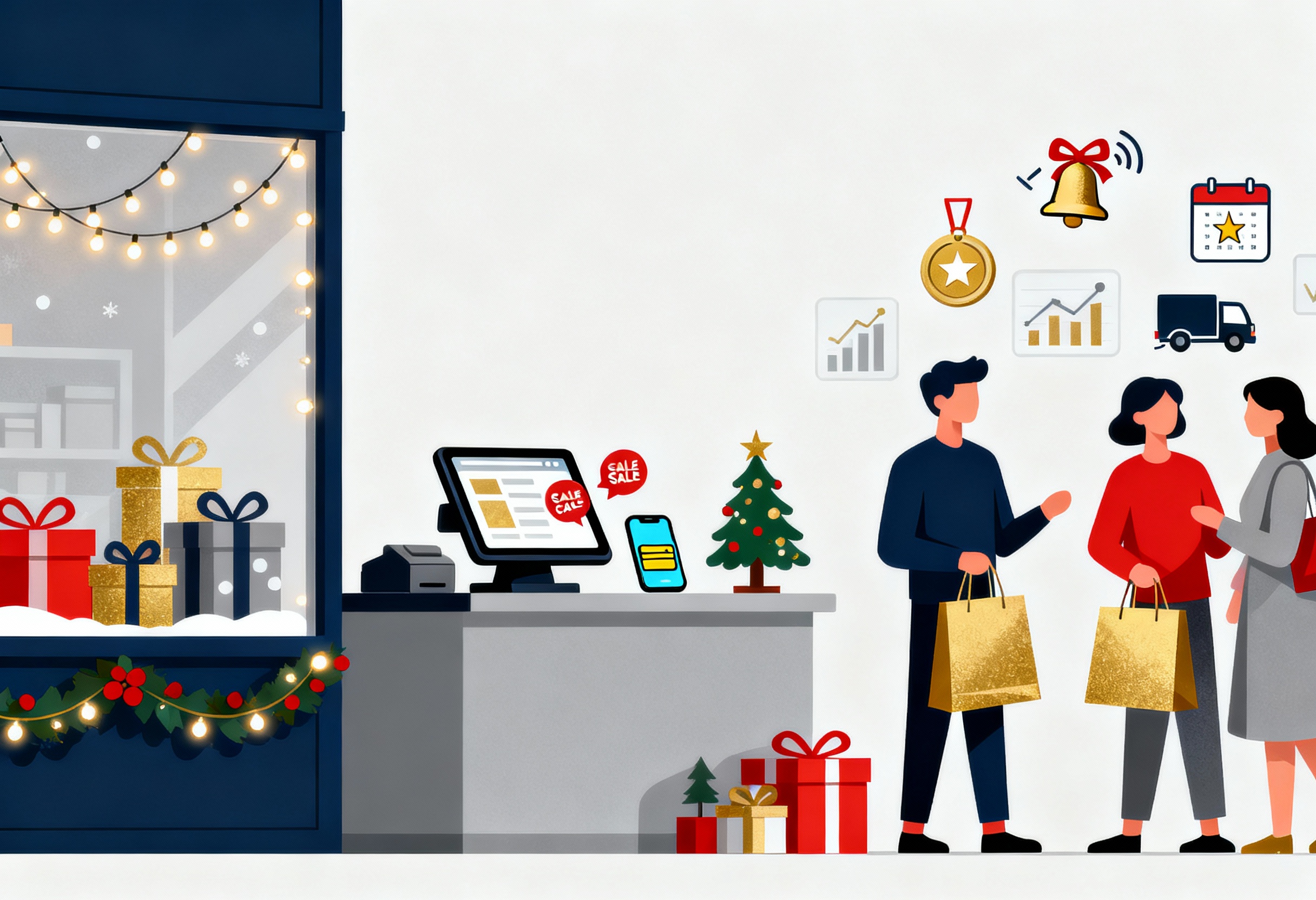The holiday season stands as a pivotal period for ecommerce businesses, holding immense potential for growth and expanded reach. Yet, with this opportunity comes a distinct set of challenges that demand careful consideration. To genuinely capitalize on this surge in consumer activity, a meticulous and well-thought-out planning approach is indispensable. Neglecting key areas within your preparation can quickly translate into lost sales, a wave of frustrated customers, and an operational experience is chaos. This article, insights by ConnectPOS, addresses common and often overlooked questions pertaining to ecommerce holiday planning, guiding you through the steps needed to prepare for what could be your most successful season yet.
Highlights:
- Smart ecommerce holiday planning starts with preparing your store. Review past data, confirm your website can handle traffic, and forecast inventory accurately. This helps avoid crashes or sell-outs during the busy season.
- Seasonal promotions work best when they match shopper behavior and key retail dates. Align your marketing and inventory to these times to reach customers when they’re most ready to buy.
Ecommerce Holiday Planning: Get Your Store Ready For The Season
The holiday season brings higher demand, tighter competition, and greater revenue opportunities. Success depends on preparation across design, branding, content, and campaign timing. Below are six key areas to focus on for a more profitable ecommerce holiday planning.
- Website Design and User Experience: Holiday shoppers expect speed and simplicity. Use festive visuals, ensure fast load times, and make navigation clear across all devices. A smooth mobile experience is no longer optional.
- Holiday Branding Across Channels: Seasonal tweaks, such as a festive logo or themed email templates, unify your brand across touchpoints. Consistency across web, ads, and social improves recognition during high-traffic periods.
- Product Listings and SEO: Update titles, descriptions, and meta tags with holiday-relevant keywords. Highlight seasonal bundles or gifts to increase visibility when buyers search with urgency.
- Holiday Promotions That Convert: Run limited-time promotions, bundle deals, or exclusive discounts. Add countdown timers or low-stock messages to drive urgency and reduce hesitation.
- Paid Ads and Targeting: Refine audience segments and match your creative to each platform. Route traffic to campaign-specific landing pages that convert without distraction.
- Social Proof and Urgency: Show customer reviews, ratings, and real-time stock updates. Trust cues and time-sensitive signals give buyers the confidence to act quickly.
What are The Steps To Win With Seasonal Promotions?
Seasonal campaigns work best when built on structure, clarity, and smart timing. Businesses that treat ecommerce holiday planning as a repeatable process rather than a single push tend to perform with more confidence and less waste. What matters most is not how loud a promotion sounds but how well it fits the moment.
The following steps focus on execution that holds under pressure. Each one builds toward campaigns that deliver outcomes while maintaining consistency throughout.
Start with Clear Campaign Objectives
Every promotion should begin with a decision about what the business is trying to achieve. Driving revenue is always on the table, but so is moving slow inventory, acquiring first-time buyers, or driving loyalty through retention. Without a clear outcome in mind, messaging tends to drift and measurement becomes guesswork.
Objectives shape how the rest of the campaign unfolds. The tactics used for reactivating past customers will look different from those used for launching a new collection. When goals are grounded early, creativity and operations stay aligned through every phase of delivery.
Mark Key Dates That Shape Buying Behavior
Seasonal promotions deliver better results when aligned with documented shopping patterns. For instance, the 2023 Thanksgiving weekend in the U.S. attracted over 200 million shoppers, setting a new record according to the National Retail Federation (NRF).

Super Saturday which is known as the last Saturday before Christmas—can generate approximately $15 billion in sales in the U.S. Mapping these fixed retail peaks alongside shipping cutoffs and key cultural days helps brands synchronize their messaging, creative assets, and inventory support to where consumer activity is most likely to occur. This careful alignment is a cornerstone of effective ecommerce holiday planning.
Once campaign dates are anchored to these behavioral milestones, internal processes gain clarity and purpose. Teams can reverse-engineer schedules for content creation, testing, approvals, and fulfillment, for example starting creative development six weeks before peak shipping days. This structure reduces last-minute pressure, helps avoid stock outs or delays, and creates a repeatable framework that supports future holiday execution.
Build a Timeline That Supports Execution
Holiday campaigns have more moving parts than regular cycles. Without a realistic schedule, small issues tend to snowball into missed launches or performance gaps. A working timeline brings creative, technical, and operational teams into alignment around shared milestones for ecommerce holiday planning.
►►► Optimal solution set for businesses: Multi store POS, Next-gen POS, Inventory Management Software (MSI), Self Service, Automation, Backorders
Deadlines should allow room for testing, revisions, and approvals. A campaign might have strong messaging but fall flat because final assets were rushed. Time protects quality. It also lets teams react without panic when something doesn’t go as planned.
Create Content That Fits the Season’s Intent
Ecommerce holiday planning thrives on personalization. 84% of customers say they want brands to understand and meet their individual needs, and email campaigns with personalized content can increase open rates by up to 29% and click-through rates (CTR) by 41%. This highlights the critical importance of tailoring marketing messages to resonate personally with the audience to drive higher engagement and effectiveness
Generic messaging rarely performs well during periods when buyers are emotionally invested. Campaigns need to reflect how people feel, what they value, and why this window matters. That might mean urgency, nostalgia, or practicality, depending on the audience.
Creatives should speak directly to those signals. A holiday email with strong visuals and timing-specific language connects better than one built from templates. Treat content as the part of the campaign customers feel first, not just something added at the end.
Highlight What Sets Your Product Apart
During peak shopping seasons, shoppers face a flood of promotions, and your message can easily be ignored. To stand out, emphasize why the timing matters and what makes your approach distinct.
For instance, instead of a generic storewide discount, imagine launching an exclusive holiday gift bundle available only for the first 100 customers. This limited quantity creates a sense of scarcity, encouraging buyers to act quickly. Pair that with early access for loyal customers before the official sale, and you add a layer of exclusivity that feels personal and timely.
Such initiatives tie directly to the season whether it’s a curated gift set or a special edition product and give customers a clear, relevant reason to pay attention. This approach avoids exaggeration, instead building genuine urgency that connects with buyers’ emotions and values.
Test, Measure, and Adjust Before It’s Too Late
Strong campaigns are rarely perfect right from the start. Testing during the rollout helps figure out which creative, format, or timing works best. Beginning with a smaller audience gives teams data they can use before wider distribution, saving both money and effort in ecommerce holiday planning.
Performance reviews during the campaign allow teams to make timely adjustments. Small changes based on live data such as subject lines, headline swaps, or timing tweaks often produce stronger results than waiting for post-campaign analysis.
What happens during the window carries more weight than anything learned after it ends. Acting in the moment can shift momentum, while delayed insights only serve the next cycle.
Match Messages to Segments That Matter
One audience rarely fits all. Repeat buyers, new visitors, and high-value customers behave differently and respond to different triggers. Tailoring messages to their habits builds more trust and earns more response.
Segmentation doesn’t need to be over-engineered. Simple groupings such as last purchase date or cart value that can guide what gets sent and when. A message that feels specific will always outperform one that tries to reach everyone.
For example, repeat buyers might respond best to loyalty rewards or exclusive early access, while new visitors may need educational content or welcome offers to build trust. High-value customers often appreciate personalized recommendations based on past purchases. Even simple segmentation such as grouping customers by last purchase date or cart value, allows brands to send messages that feel relevant and timely.
This tailored approach not only increases engagement but also fosters stronger relationships, proving far more effective than generic campaigns aimed at everyone.
Prepare Inventory and Support Around Demand Patterns
Holiday campaigns can quickly unravel when popular products sell out or customer support lines become overwhelmed. To avoid this, marketing teams must stay closely synchronized with warehouse and service departments. This guarantees promises made in promotions can be fulfilled reliably for ecommerce holiday planning.
A best practice is to conduct pre-launch reviews involving marketing, inventory, and customer service teams. These meetings help identify potential risks such as limited stock or expected surges in inquiries. Equipping support staff with clear talking points and surge plans ensures they can confidently handle customer questions without confusion.
For example, a retailer launching a limited-edition holiday gift set might:
- Coordinate with the warehouse to confirm exact inventory levels and replenishment schedules.
- Provide customer service with real-time inventory access and FAQs about availability and shipping times.
- Develop contingency plans if demand exceeds supply, such as providing backorders or alternative product suggestions.
The integration between inventory management and customer support with marketing campaigns, businesses can capitalize on holiday demand surges without risking stock outs or service breakdowns. It is supported by industry best practices emphasizing demand forecasting, cross-team communication, and real-time inventory tracking to optimize holiday sales and customer satisfaction
Track And Improve Your Ecommerce Holiday Planning Campaigns
Holiday campaigns run on limited time and tight margins. When performance begins to shift, brands that pay attention to the right signals can respond early. This requires more than passive observation. It’s about measuring what matters, analyzing patterns in real-time, and acting on clear signals before momentum fades.
The five areas below often separate reactive campaigns from high-performing ones.
- Define the Right KPIs for the Season: Tracking everything means understanding nothing. Pick metrics that reflect how your business converts demand into revenue. Sales volume without context won’t tell you where buyers drop off. Conversion rate, cart abandonment, customer acquisition cost, and return on ad spend provide a clearer view of channel performance and shopper intent.
- Use Analytics to Read Behavior, Not Just Volume: Page views and traffic spikes may look encouraging, but real insight comes from understanding what people do after they land. Tools like Google Analytics and platform-native dashboards give a breakdown of how buyers move through the funnel. Focus on how quickly people reach checkout, what causes exits, and which sources drive real transactions.
- Track Inventory Like It’s a Campaign Asset: No promotion survives poor inventory control. High-demand products that go out of stock too early can erode trust, while slow-moving items tie up capital. Match stock levels with marketing plans, and use real-time updates to flag pressure points. Treat inventory as part of your campaign, not a background task.
- Monitor Campaign Channels Separately: Marketing tactics often perform unevenly across platforms. Bundling all data into a single performance snapshot hides what’s really working. Break down campaign results by channel such as email, paid search, organic social, and affiliates. Focus on return instead of reach. Redirect attention toward the sources that drive actual conversions rather than those that simply generate traffic.
- Let Customer Feedback Shape the Next Move: Data explains behavior, but feedback gives it meaning. Monitor reviews, chat transcripts, and post-purchase surveys to hear what customers won’t say in metrics. If complaints spike around delivery time or product quality, use that input to adjust messaging or logistics before sales peak. Feedback is often the early signal that something’s off-track.
Maximize Holiday Sales With ConnectPOS
As the holiday shopping frenzy approaches, retailers face the yearly challenge of turning increased foot traffic and online engagement into actual sales. The right point-of-sale (POS) system does more than just process transactions; it acts as a strategic ally, helping you connect with customers, manage inventory, and create a smooth shopping experience. ConnectPOS can help you turn holiday potential into a record-breaking season.
- Unified Sales Channels: ConnectPOS brings together your sales channels, ending fractured customer data and inventory counts. Every interaction, from in-store purchases to online orders, feeds into one omnichannel system, giving you a complete picture of your business. This unification lets customers start shopping in one place and finish in another without any issues.
- Real-time Inventory: The ability to access real-time inventory information is key during the holidays. With ConnectPOS, your sales associates know exactly what’s in stock, whether it’s on the sales floor or in the backroom. This accuracy cuts down on missed sales and keeps customers happy, preventing the frustration of out-of-stock items.
- Fast Transactions: Speed at the checkout counter can make or break a holiday shopping experience. ConnectPOS helps you process transactions quickly, cutting down on lines and keeping customers moving. This rapid processing is just as important for online orders, as customers expect their digital purchases to go through without delay.
- Customer Relationships: ConnectPOS lets you build stronger customer relationships. It helps you gather valuable data on buying habits and preferences, letting you tailor promotions and product recommendations. A personalized approach makes customers feel valued and can turn one-time holiday shoppers into loyal patrons.
- Consistent Experience: Whether your customers are shopping in your physical store or browsing your online catalog, ConnectPOS helps you deliver a consistent and enjoyable experience. This consistency builds trust and encourages repeat business, extending the impact of your holiday efforts well beyond the season itself.
The holiday season is an opportunity to showcase your brand and build lasting customer relationships. With ConnectPOS, you put yourself in a position to not only meet the demands of increased sales volume but to also create a memorable experience for every shopper.
FAQ: Ecommerce Holiday Planning
What’s the most important first step for ecommerce holiday planning?
Start by looking at your past holiday performance. Review sales data, website traffic, conversion rates, and customer service inquiries from previous years. This historical view shows you patterns, popular products, and what caused problems. Knowing what worked and what didn’t helps you build a smarter strategy this year.
When should planning start?
Ideally, 2–3 months before peak holidays. Early planning helps manage inventory, campaigns, and logistics smoothly.
How can I prepare my customer service team for the holiday rush?
Expect many more customer questions across all channels. Add more staff to your customer service team and give them good training on common holiday issues, like shipping delays, return policies, and gift card use. Adding self-service options, like a detailed FAQ page or chatbots for simple questions, can also help manage the volume and free up your agents for harder issues.
Conclusion
A truly holiday ecommerce season is never a matter of chance; it is the direct outcome of meticulous planning and proactive preparation. When you address these important considerations with thorough ecommerce holiday planning, you place your business in a commanding position to effectively manage the heightened demand, consistently meet and even surpass customer expectations, and ultimately thrive during this intensely busy and remarkably profitable segment of the year.
Discover how ConnectPOS can support your holiday success by visiting our website or speaking with our sales team today. Contact us now!
►►► Optimal solution set for businesses: Shopify POS, Magento POS, BigCommerce POS, WooCommerce POS, NetSuite POS, E-Commerce POS



